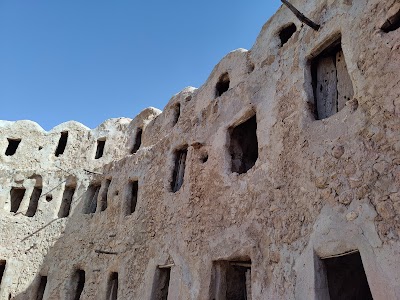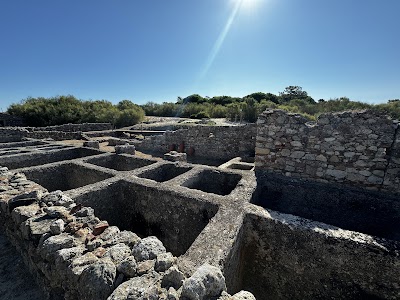Qasr al-Haj (قصر الحاج)
Overview
Discovering Qasr al-Haj: A Hidden Gem in Libya
Nestled in the Sabha District of Libya, Qasr al-Haj, or "Qasr al-Hadj" as it is known locally, stands as a captivating testament to the architectural ingenuity and cultural richness of North Africa's past. This extraordinary granary fortress offers a unique blend of history, tradition, and breathtaking desert landscapes, making it a must-visit destination for any traveler eager to explore the ancient heritage of the region.
A Historical Fortress
Dating back to the 12th century, Qasr al-Haj was originally built by the Berber tribes as a fortified granary. Its primary purpose was to provide a secure space for communities to store grain and other essential goods. In an era marked by scarcity and the constant threat of raiders, this fortress became a symbol of communal cooperation and resilience, safeguarding vital supplies against theft and spoilage.
Architectural Marvel
The structure of Qasr al-Haj is nothing short of remarkable. From above, it resembles a giant beehive, a design that is both visually stunning and highly functional, maximizing storage capacity while ensuring efficient management. Constructed from mud-brick and enhanced with lime plaster, the fortress has successfully withstood the test of time and the harsh desert climate.
Exploring the Interior
Upon entering Qasr al-Haj, visitors are greeted by a spacious central courtyard surrounded by multiple levels of storage rooms, known as "ghorfas." Each ghorfa, privately owned by families or groups, is a small, windowless chamber designed to maintain a cool temperature—ideal for preserving grains and foodstuffs. As you explore the narrow staircases and winding passages, you’ll gain insight into the communal storage practices that defined life in this ancient desert community.
Inscriptions and Decorations
One of the most fascinating features of Qasr al-Haj is its well-preserved inscriptions and decorations found on the walls of the ghorfas. These inscriptions often include the names of the owners and the dates when grain was stored, serving as a historical ledger etched in plaster. Such details provide visitors with a tangible connection to the people who once relied on this fortress for survival, illuminating its extensive use over the centuries.
Cultural Significance
Beyond its historical value, Qasr al-Haj holds deep cultural and societal importance for the Berber community. It symbolizes their ingenuity and endurance, reflecting a sophisticated understanding of communal resource management long before modern storage solutions emerged. The fortress also embodies the Berbers' profound connection to the land and their remarkable ability to thrive in one of Earth's most challenging environments.
A Journey Through Time
Visiting Qasr al-Haj is not merely about observing an ancient structure; it offers a unique opportunity to step back in time and immerse yourself in a crucial piece of Libyan heritage. Easily accessible from the nearby town of Sabha, the fortress makes for an ideal day trip for those exploring the broader region. Guided tours are highly recommended, as local guides provide invaluable insights into the fortress's history, architecture, and cultural context.
Planning Your Visit
When planning your visit, it’s essential to consider the desert climate. The best time to explore Qasr al-Haj is during the cooler months, from late autumn to early spring. Morning or late afternoon visits are ideal to avoid the intense midday heat and to experience the soft, golden light that beautifully illuminates the mud-brick walls.
Reflecting on the Past
As you wander through Qasr al-Haj, take a moment to reflect on the lives of those who built and utilized this remarkable structure. Envision the bustling market days, the strategic discussions among tribal elders, and the quiet moments of everyday life within this ancient desert community. Each stone and ghorfa at Qasr al-Haj tells a story, inviting you to connect with its enduring legacy.
A Rich Experience Awaits
Qasr al-Haj is more than just a historical site; it’s a symbol of human resilience, cultural heritage, and architectural brilliance. For anyone traveling through Libya, a visit to this extraordinary granary fortress offers an enriching experience that deepens your understanding of the region's past and its people. Whether you’re a history buff, an architecture enthusiast, or simply a curious traveler, Qasr al-Haj promises an unforgettable journey into the heart of Libya's Berber heritage.






